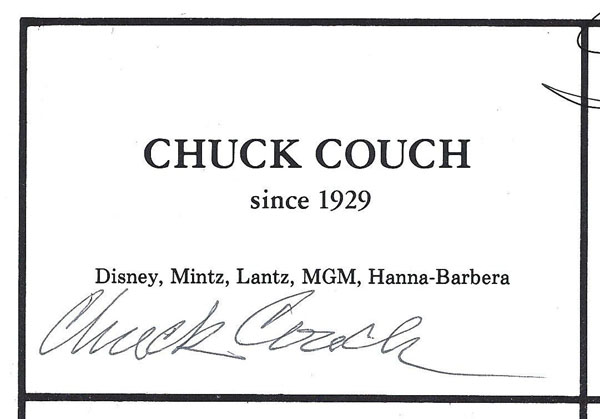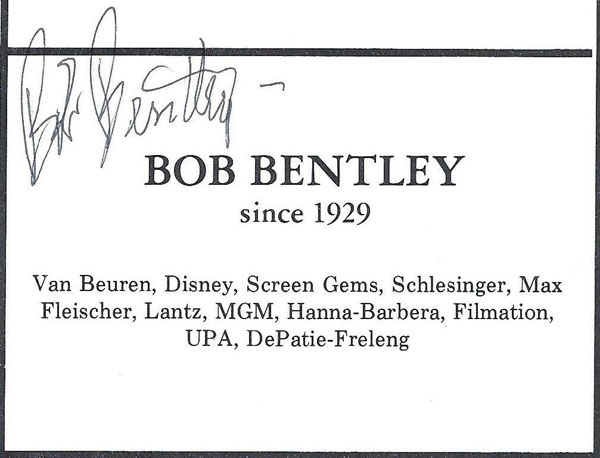Both Charles Scovil Couch and Robert Jarvis Bentley were journeymen animation artists whose works and/or careers have attracted, at best, only modest attention. My video encounter with Couch was rather abrupt, as he really wanted to go back to the party. Bentley was more congenial, but only a bit more informative; interestingly, it seems to be one of the few times, if any, he was ever interviewed on camera.

Chuck Couch has been discussed before on Cartoon Research. There is Charles Brubacker’s post on The Tiny Tree (DePatie-Freleng, 1975), a fondly remembered Christmas special first shown as part of the Bell System Family Theater on NBC. The other was Mike Kazaleh’s piece that discussed another Bell System project, Mr. Digit and the Battle of Bubbling Brook (1961), a live-action/animation industrial film explaining AT&T’s switchover to all number dialing, for which Couch was animation director.
Like a number of other artists from the period, Couch is sometimes known for the more famous people he worked with than for his own work, including his childhood friend Fred Moore. He began his career at Disney as an inbetweener in 1929 and soon moved up to being an animator, where Art Babbitt became one of his inbetweeners in 1932. Writing on his BabbitBlog, Jake Friedman noted that, “Couch measured an insecure 5’8″ and was just 23 years old. He generally worked fast and broad on comic scenes, but wasn’t considered especially versatile. His company review describes him as being ‘inclined towards griping. Is not too dependable on getting a good result. Very inconsistent.’” Obviously, he was able enough to stay on as an animator, including working on Clock Cleaners (1937). He also teamed up with Carl Barks on the Donald Duck unit as a storyman (or gagman as he liked to put it) and his only feature credit there was working on story for Bambi (1942).
Couch, before going into the service, then moved over to do story work for Walter Lantz, a move perhaps sparked by the layoffs that followed the 1941 Disney strike. (Speaking of the strike, was he related to Glen Couch, a picket captain and Disney assistant animator?) In 1946, according to the New York union newsletter Top Cel, MGM announced he would be part of “an all-veteran cartoon unit of returned servicemen and women.” I don’t know if that came to pass, but he did work for MGM. He later opened Chuck Couch Associates, which made Talking of Tomorrow (1960) an industrial film for AT&T (embed above). He ended his career at Hanna-Barbera being a gagman on such shows as The 13 Ghosts of Scooby-Doo (1985).

Bob Bentley seemed to have been a well respected animator for much of his career, which began in 1929 at Van Beuren. He came out to the West Coast in 1935 to work for Disney, before going over to Schlesinger’s to work as an animator in Frank Tashlin’s unit (which is where most sources start his filmography). He went down to Miami to animate on Fleischer’s Gulliver’s Travels, which was his only feature credit.
Otherwise, he seemed to bounce around from studio to studio over the years, initially in theatrical shorts (Lantz, MGM, etc.) and later on TV series (Hanna-Barbera, DePatie-Freleng, Filmation, etc.). A very brief sketch of his career by Joe Campana is found here, and Don Yowp even more briefly tries to engage with his animation style and career here. Despite the fact that he worked on a number of important cartoons, including Tex Avery’s King-size Canary (1947), aside from perhaps Frank Tashlin’s comment to Michael Barrier that he was “a very good animator,” there doesn’t seem to be much out there on him, so I should let him speak for himself.
However, I should point out that Bentley’s stepfather was Les Elton, the silent era animator (he once worked for J.R. Bray) best known for the cultoons Monkey Doodle (1931) and Hobo Hero (1935). (Charlie Judkins posted a nice bio of Elton here and Steve Stanchfield posted a short piece on his most famous films here.) If I had only known that when I spoke to him!
As a reminder, this and other video interviews in this series took place on Friday evening, January 20, 1984, at Sorrentino’s Restaurant, in Toluca Lake, during the Motion Picture Screen Cartoonists’ first Golden Awards Banquet. For more details on the event, check out my first post in this series here.
Next week: Paul Fennell.


 Harvey Deneroff is an independent film and animation historian based in Los Angeles specializing in labor history. The founder and past president of the Society for Animation Studies, he was also the first editor of Animation Magazine and AWN.com. Harvey also blogs at deneroff.com/blog.
Harvey Deneroff is an independent film and animation historian based in Los Angeles specializing in labor history. The founder and past president of the Society for Animation Studies, he was also the first editor of Animation Magazine and AWN.com. Harvey also blogs at deneroff.com/blog.




































































Paul Fennell can be glimpsed at 0:09 into the Bob Bentley video, at screen right.
When I was a staff writer at Hanna-Barbera, I looked up one day to see Chuck Couch slowly entering my office and making his way toward me. I was surprised, since I’d never really had much to say to Chuck, and I had no idea why he’d be coming to talk to me. He got right up to my desk and looked past me, gazing intently at the wall near me. I had a Disney calendar hung on my wall, and each month on the calendar featured a picture from a classic Disney cartoon or movie. That month’s picture was an animation pencil drawing from “Clock Cleaners” featuring Mickey, Donald and Goofy. After examining the picture quietly for a long while, he finally muttered, “Yeah, that looks like one of my drawings,” and then he quietly shuffled out.
That’s what it was like working at H&B in the eighties.
Might be too late now, but I know for sure Bob Bentley animated the opening scenes with Porky and his mother in Tashlin’s WHOLLY SMOKE. (The exposure sheet– housed in a private collection — indicates his name.)
Chuck Couch Associates may have animated some of the intermission trailers that are up on you tube. After exaniming “Talking about tomorrow with the intermission with the animation I have concluded that Couches studio produced it. The designs look like Bill Perez or an Hanna Barbara freelancer worked on them.
https://www.youtube.com/watch?v=vpu2c7Wfang